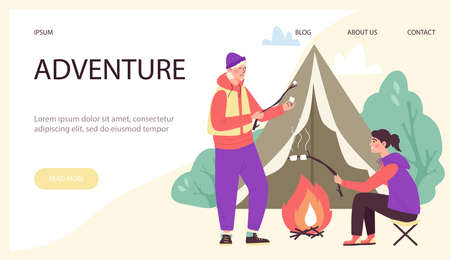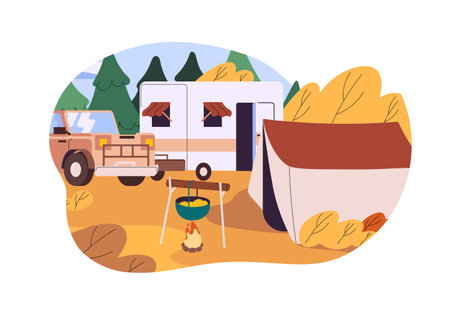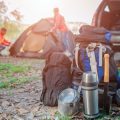Introduction to Seasonal Camping in the US
When it comes to camping in the United States, there’s an incredible diversity of experiences waiting for outdoor enthusiasts. From towering pine forests in the Pacific Northwest to tranquil lakes nestled in the Midwest and sun-dappled woodlands across the South, America’s campgrounds offer something unique in every region and season. But planning a trip isn’t just about choosing a destination—it’s about understanding how seasons and regional climates will shape your adventure. Whether you’re dreaming of crisp autumn hikes beneath golden leaves or summer afternoons paddling across crystal-clear waters, knowing when and where to go is key. In this guide, we’ll explore how seasonal changes affect forest and lake campgrounds across America, helping you make the most of your next outdoor escape.
2. Spring Escapes: Where to Camp as Nature Awakens
Spring is a magical time for outdoor enthusiasts—forests and lakes across America burst into color as wildflowers bloom and wildlife becomes more active. If youre eager to shake off winters chill, spring camping offers mild temperatures and fewer crowds before the summer rush. Here are some top forest and lake campgrounds perfect for your springtime adventures, along with practical advice for making the most of your trip.
Top Spring Camping Destinations
| Campground | State | Main Features |
|---|---|---|
| Great Smoky Mountains National Park | Tennessee/North Carolina | Breathtaking wildflower displays, mountain streams, scenic hiking trails |
| Shenandoah National Park | Virginia | Blooming dogwoods, panoramic overlooks, Appalachian Trail access |
| Lake Tahoe Basin Management Unit | California/Nevada | Sparkling alpine lake, snow-capped peaks, forested sites |
| Boundary Waters Canoe Area Wilderness | Minnesota | Lakeside campsites, canoe routes, awakening wildlife |
| Ozark National Forest – Blanchard Springs Recreation Area | Arkansas | Caves, waterfalls, wildflower meadows |
What Makes Spring Special?
The transition from winter to spring transforms campgrounds into vibrant landscapes. Temperatures usually range from the high 50s to low 70s (°F), which is ideal for hiking and enjoying campfires. Trails are lined with fresh greenery, and birdsong fills the air—a welcome change after months of quiet woods or frozen lakes.
Tips for Navigating Spring Hazards
- Muddy Trails: Bring waterproof boots and gaiters. Stick to established paths to avoid damaging sensitive new growth.
- Lingering Snow: In higher elevations like Tahoe or the Smokies, patches of snow can persist into late spring. Pack layers and check local trail reports before heading out.
- Bugs and Ticks: Use insect repellent and do regular tick checks, especially in Eastern forests as temperatures rise.
Bonus Tips for a Smooth Spring Camping Trip
- Reserve campsites early—popular spots fill up fast once the weather warms.
- If you’re sensitive to pollen, consider bringing allergy medication.
- Packed trails are less likely in spring, but always practice Leave No Trace principles as ecosystems recover from winter dormancy.
With careful planning and a sense of adventure, spring camping in Americas forests and lakes can be a rejuvenating experience. Embrace the season’s renewal and enjoy nature’s grand reawakening at some of the country’s most beautiful campgrounds.

Summer Hotspots: Cooling Off by the Lakes
When summer arrives, America’s lake campgrounds transform into bustling hubs of outdoor fun and relaxation. From the crystal-clear waters of Lake Tahoe in California to the iconic shorelines of Lake George in New York, these destinations are classic escapes for families and adventurers alike. Swimming, kayaking, paddleboarding, and fishing dominate the scene, offering endless ways to beat the heat while soaking up scenic views.
Top Destinations for Summer Lake Camping
Some perennial favorites include:
- Lake Chelan, Washington: Known for its warm weather and inviting beaches, perfect for swimming and boating.
- Boundary Waters, Minnesota: A paradise for canoe enthusiasts and anyone seeking a peaceful retreat surrounded by forested shores.
- Lake Powell, Arizona/Utah: Famous for dramatic red rock scenery and houseboat adventures.
Booking Your Campsite: Plan Ahead!
Summer is peak season at these lakeside hotspots, so campsites can fill up fast—sometimes months in advance. Most national parks and popular state parks use reservation systems like Recreation.gov or ReserveAmerica. Set reminders for when bookings open (often six months out) and be ready to reserve early in the morning to snag your ideal spot.
Tips for Staying Cool
- Choose shaded campsites or bring a canopy to create your own cool zone.
- Swim early or late in the day to avoid midday sunburns.
- Stay hydrated and pack plenty of sunscreen—lake reflections intensify UV exposure.
Whether you crave peaceful mornings on a paddleboard or afternoons splashing with family, America’s summer lake campgrounds offer an iconic way to embrace the season. With a little planning, you’ll have a front-row seat to some of the best water recreation the country has to offer.
4. Fall Adventures: Chasing Color in the Forests
Autumn is a magical time to explore America’s forest and lake campgrounds, as the landscape transforms into a patchwork of brilliant reds, oranges, and golds. The crisp air makes hiking and outdoor activities more invigorating, while seasonal events bring local flavor to your camping experience. From New England’s iconic foliage to the tranquil shores of Midwestern lakes, fall offers unique opportunities for campers who want to immerse themselves in nature’s grand finale.
Best Regions for Fall Camping
| Region | Top Campgrounds | Notable Features |
|---|---|---|
| Northeast (Vermont, New Hampshire) | White Mountain National Forest, Green Mountain National Forest | Spectacular foliage, maple festivals, apple picking |
| Midwest (Michigan, Wisconsin) | Pictured Rocks National Lakeshore, Devil’s Lake State Park | Lakeside views with colorful forests, cranberry harvests |
| Pacific Northwest (Oregon, Washington) | Mount Hood National Forest, Olympic National Park | Misty mornings, mushroom foraging, salmon runs |
| Southeast (North Carolina, Tennessee) | Great Smoky Mountains National Park, Pisgah National Forest | Long foliage season, local cider mills, music festivals |
Seasonal Activities to Enjoy
- Leaf Peeping: Plan hikes or scenic drives to catch peak color—local ranger stations can provide updates on timing.
- Crisp Weather Hiking: Cooler temperatures mean fewer bugs and less humidity; pack layers for changing conditions.
- Paddling & Fishing: Many lakes are less crowded but still accessible; enjoy peaceful waters surrounded by autumn hues.
- Harvest Events: Check out nearby farmers’ markets or orchards for pumpkin patches, corn mazes, and fresh pies.
- Campfire Evenings: Early sunsets make for long nights around the fire—perfect for storytelling and s’mores.
Tips for Fall Camping Comfort
- Bring extra insulation and cold-weather gear; temperatures can drop sharply at night.
- Reserve campsites early—fall weekends are popular in high-foliage regions.
- Be mindful of wildlife preparing for winter; store food securely and follow Leave No Trace principles.
- If you’re traveling during harvest festivals or local events, expect increased traffic and book accommodations in advance.
The Takeaway: Savor Autumn’s Richness Outdoors
Fall camping across America isn’t just about the colors—it’s about slowing down to appreciate the harvest season, engaging with local traditions, and embracing the cozy side of outdoor life. Whether you’re wandering through a golden forest or sipping hot cider by the lake, autumn adventures offer a distinct American camping experience that combines natural beauty with cultural celebration.
5. Winter Retreats: Embracing the Quiet Season
Discovering the Magic of Winter Camping
When most people think of camping, they picture summer sun and bustling campgrounds. But for those willing to embrace winter’s chill, forest and lake campgrounds across America reveal a new side of their beauty—peaceful, pristine, and almost entirely your own. Many regions from the Pacific Northwest to the Adirondacks keep select sites open year-round, making winter camping an accessible adventure for those prepared to brave the elements.
Essential Winter Gear Checklist
- Four-season tent: Designed to withstand snow loads and cold winds.
- Insulated sleeping bag: Rated at least 10°F lower than expected temperatures.
- Sleeping pad: An insulated pad to prevent heat loss through the ground.
- Layered clothing: Wool or synthetic base layers, mid-weight insulation, and waterproof outerwear.
- Cold-weather boots and wool socks: Keep feet dry and warm during snow hikes or around camp.
- Portable stove: Liquid fuel stoves work best in freezing temperatures; always pack extra fuel.
Safety First: Winter Campground Considerations
- Check accessibility: Before you go, confirm that roads and trails are open and safe for travel.
- Avoid thin ice: Never walk on frozen lakes unless local authorities have declared them safe.
- Monitor weather changes: Sudden storms or extreme cold can roll in quickly—keep a weather radio handy.
- Pace yourself: Cold weather can make even short hikes more strenuous. Take breaks often and stay hydrated.
Enjoying Tranquility in the Off-Season
The true reward of winter camping is the serenity. Crisp air carries sound differently; forests feel hushed beneath blankets of snow. Morning mist rises off icy lakes, and you may spot animal tracks you’d never see in summer. Try snowshoeing along quiet trails, sipping hot cocoa by a crackling fire, or simply enjoying star-filled skies unspoiled by crowds or bugs. For those craving solitude and reflection, America’s winter campgrounds offer an unforgettable retreat into nature’s stillness—just remember, preparation is key to making it magical instead of miserable.
6. Essential Tips for Camping Success Year-Round
Whether you’re exploring the misty forests of the Pacific Northwest in spring or relaxing beside a sun-soaked lake in the Midwest during summer, preparation is key to an unforgettable camping experience. Here are some practical tips to help you stay safe, have fun, and protect America’s natural beauty all year long.
Gear Up for Every Season
Always check the weather forecast before your trip and pack accordingly. Layering is crucial—think moisture-wicking base layers for summer hikes or insulated jackets for chilly autumn nights. Don’t forget sturdy boots, rain gear, and a reliable tent with a quality rainfly. For lakeside trips, bring water shoes and sun protection; forest campers should pack insect repellent and bear-proof food containers where required.
Know the Local Rules
Every state and national campground has its own set of regulations, from quiet hours to pet policies. Before heading out, visit the official park website or contact a ranger station to understand reservation requirements, fire bans, and trail closures. This simple step helps avoid surprises—and fines—during your stay.
Stay Wildlife Smart
Wildlife encounters are part of the adventure but require caution. Store food and scented items in bear lockers or airtight containers. Never feed animals, even if they seem friendly. At lakeshores, watch for snakes and keep a respectful distance from nesting birds. In forested areas, learn to identify poison ivy and check for ticks after hikes.
Campfire Safety and Restrictions
Campfires are a cherished camping tradition but can quickly become dangerous. Always follow posted campfire restrictions, especially during dry months when wildfire risk is high. Use designated fire rings or grills, keep fires small, and never leave them unattended. Extinguish completely using water—never just dirt—before leaving your site or turning in for the night.
Practice Leave No Trace
No matter the season, following Leave No Trace principles keeps our forests and lakes pristine for future generations. Pack out all trash, even biodegradable items like orange peels or sunflower seeds. Stick to marked trails to prevent erosion, respect wildlife habitats, and leave what you find for others to enjoy.
Your Adventure Awaits—Responsibly
A little planning goes a long way toward an enjoyable and sustainable camping trip across America’s incredible landscapes. By gearing up properly, respecting local guidelines, staying wildlife aware, managing campfires safely, and committing to Leave No Trace practices, you’ll ensure that your outdoor adventures remain safe—and that these wild places remain beautiful—all year round.

